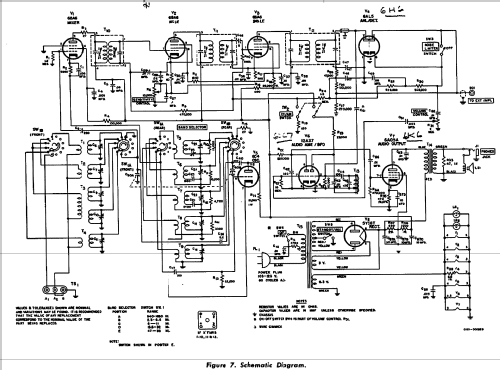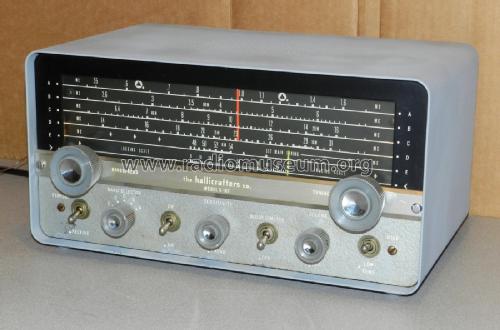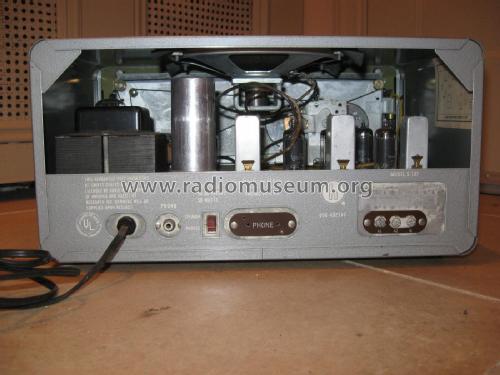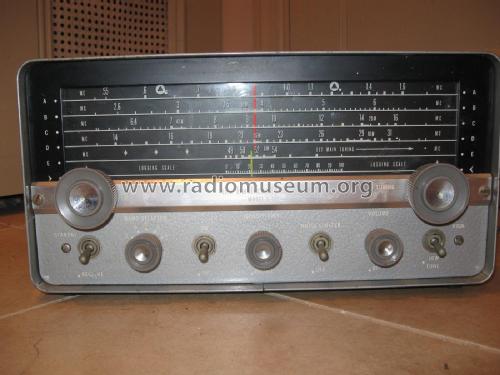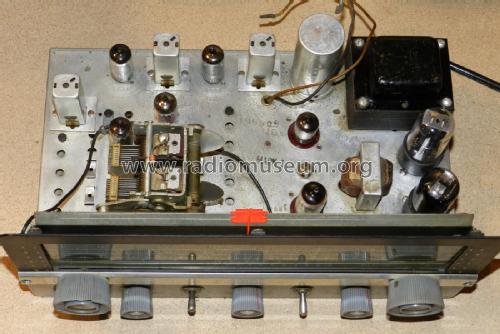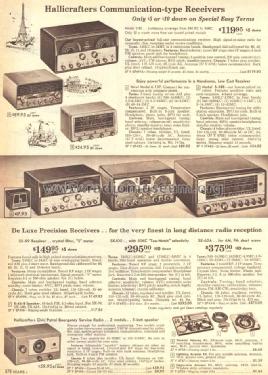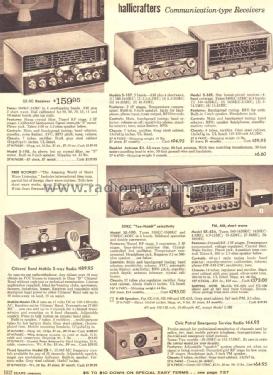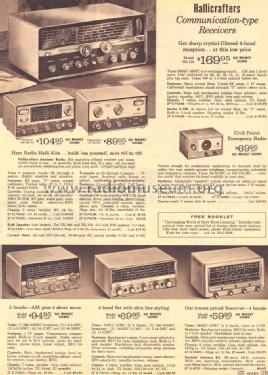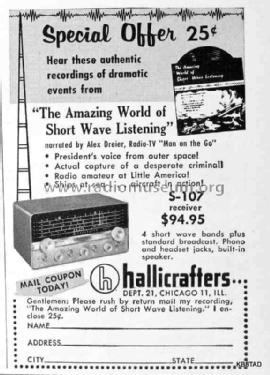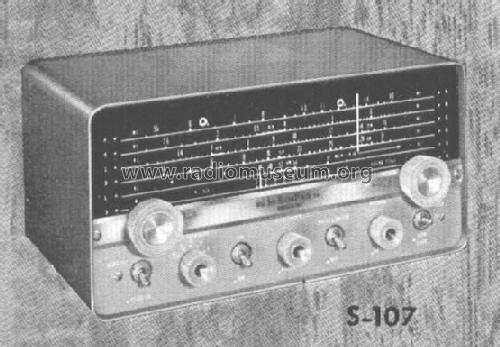- Pays
- Etats-Unis
- Fabricant / Marque
- Hallicrafters, The; Chicago, IL and Arlington/Grand Prairie, TX
- Année
- 1958–1962
- Catégorie
- Récepteur amateur (bandes amateurs, ev. avec bande AM)
- Radiomuseum.org ID
- 79166
Cliquez sur la vignette du schéma pour le demander en tant que document gratuit.
- No. de tubes
- 8
- Principe général
- Super hétérodyne (en général); FI/IF 455 kHz
- Gammes d'ondes
- PO et plus que 2 x OC
- Tension / type courant
- Alimentation Courant Alternatif (CA) / 105-125 Volt
- Haut-parleur
- HP dynamique à aimant permanent + bobine mobile / Ø 5 inch = 12.7 cm
- Puissance de sortie
- 1 W (qualité inconnue)
- Matière
- Boitier métallique
- De Radiomuseum.org
- Modèle: S-107 - Hallicrafters, The; Chicago,
- Forme
- Modèle de table profil bas (grand modèle).
- Dimensions (LHP)
- 340 x 225 x 178 mm / 13.4 x 8.9 x 7 inch
- Remarques
-
Coverage: 0.54-1.63, 2.5-6.3, 6.3-16, 14-31, 48-54.5MHz, the S-107 replaces the S-53A
The original price of $60 is from the Radio by Hallicrafters book (1996, page 69). This price most likely is a typo since it appears low for a model of this type. The 1959 Sears ad lists this radio for $89.95 and that price appears to be more reasonable.
- Poids net
- 7.2 kg / 15 lb 13.7 oz (15.859 lb)
- Prix de mise sur le marché
- 60.00 $
- Source
- Communications Receivers
- Littérature
- Radios by hallicrafters
- Schémathèque (1)
- Shortwave Receivers - Past & Present (3rd ed.)
- Schémathèque (3)
- Sears, Roebuck Catalogs (Silvertone) (Fall/Winter 1960, page 1312. Fall/Winter 1961, page 1231.)
- Schémathèque (4)
- Sears, Roebuck Catalogs (Silvertone) (Spring/Summer 1959, page 878. (Order=57Y 07452))
- Auteur
- Modèle crée par d'un membre de D. Voir les propositions de modification pour les contributeurs supplémentaires.
- D'autres Modèles
-
Vous pourrez trouver sous ce lien 954 modèles d'appareils, 488 avec des images et 556 avec des schémas.
Tous les appareils de Hallicrafters, The; Chicago, IL and Arlington/Grand Prairie, TX
Collections
Le modèle fait partie des collections des membres suivants.
Contributions du forum pour ce modèle: Hallicrafters, The;: S-107
Discussions: 2 | Publications: 5
Our member Sinisa Trlin has the following problem:
Why is the Twin Diode 6AL5 filament heating reduced by a 6.8 ohm series resistor?
Specified for 6.3 V / 0.3 amp it is connected via said resistor to the common 6.3 V filament supply.
Such is found in many (all?) post-war models, e.g. S-40, S-53, S-76, 8R40, SX-90,
SX-130, etc.
Pre-war models S-19R and SX-24 are not equipped wich such a series resistor.
Even VTVMs are using the heater reduction.
Same is found for other Twin Diodes like 6H6 or EAA91.
What is the technical reason to reduce emission in such tubes?
To reduce the residual current at the characteristic bend?
Konrad Birkner † 12.08.2014, 17.Mar.13
Unser Mitglied Sinisa Trlin bat mich folgendes zu fragen:
Warum wird die 6AL5 absichtlich unterheizt?
Sie hat einen 6,8 Ohm Vorwiderstand, obwohl sie mit 6.3 V 0,3 A spezifiziert ist und die Heizspannung für das gesamte Gerät ebenfalls 6,3 V beträgt?
Das findet sich bei vielen (evtl.allen?) Nachkriegsmodellen, z.B. S-40, S-53, S-76, 8R40,
SX-90, SX-130 etc.
Die Vorkriegsmodelle S-19R und SX-24 verwenden keinen Vorwiderstand.
Auch bei Röhrenvoltmetern findet sich Unterheizung der Duodiode (z.B. auch 6H6 oder EAA91 u.a.).
Was ist der genaue Grund Signal-Messgleichrichterdioden zu unterheizen?
Anlaufstrom / Kennlinienknick?
Konrad Birkner † 12.08.2014, 17.Mar.13
